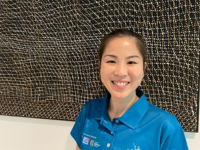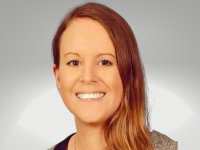This September, leading experts in respiratory medicine will converge in Vienna, Austria, for the European Respiratory Society (ERS) International Congress.
Scheduled from 7 to 11 September, the Congress will feature the latest advancements in respiratory science, covering a wide range of topics such as sleep and breathing disorders, airway diseases, paediatric respiratory conditions, and respiratory infections.
Researchers from the Wal-yan Respiratory Research Centre are proud to be part of this prestigious event, contributing their expertise to the Congress' outstanding scientific programme.
Here is a preview of some of the presentations from the Wal-yan Centre team:
Associate Professor Shannon Simpson

Invited speaker at the ‘Post-prematurity lung disease: from birth to adulthood’ symposium, and for the ‘State of the art paediatric clinical session’.
Presentation 1: Lifelong lung function trajectories in post-prematurity lung disease
This presentation will focus on what is known about lung function trajectories across the lifespan for those born prematurely, and risk factors for poor lung function trajectory in this population. The presentation will include some preliminary analyses from the ERS clinical research collaboration ‘PELICAN’ (Prematurity’s Effects on the Lungs In Children and Adults Network).
Presentation 2: Preschool lung function: which test is helpful in clinics?
Lung function testing is an essential test in children because it provides objective evidence of lung disease/health. With advances in technology, various tests are available that can aid the diagnosis of lung disease, assess progression and the response to therapy, and document lung development and evolving lung diseases in young children. Which test is useful in clinics is still a matter of debate, and this will be reviewed in this talk.
Dr Denby Evans

Invited speaker in the ‘Modelling external influence on lung health and disease susceptibility’ session.
Presentation: Delayed airway epithelial repair is correlated with airway obstruction in young adults born very preterm
Dr Evans was invited to ERS to give a repeat performance of a talk presented in Portugal earlier this year. Her presentation discusses how the cells in the airway may contribute to ongoing lung disease in survivors of preterm birth. Specifically, her talk focuses on whether the speed the airway cells can repair from injury is associated with clinical outcomes such as lung function and respiratory hospitalisations.
Dr Harriet Crabtree

Oral presentation in the ‘General characteristics of cystic fibrosis and impact of cystic fibrosis transmembrane conductance regulator modulators on the disease’ session
Presentation: IgE and Eosinophil count at 6 years predicts long-term risk of ABPA in CF patients
Allergic bronchopulmonary aspergillosis (ABPA) is a hyper-sensitivity reaction in the lungs in response to the Aspergillus fungus. Patients with ABPA tend to present with wheeze, shortness of breath on exertion and a dry cough, which can make it difficult to diagnose as these symptoms are commonly seen in patients with cystic fibrosis (CF). Due to this overlap in symptoms, ABPA is often diagnosed after lung damage has already occurred.
Patients with CF undertake annual screening to check for a range of complications, including ABPA. This annual screening includes blood tests which check total IgE, IgE levels specific to Aspergillus and eosinophils, as well as a CT scan of the lungs.
In our study, we have looked back through the data from our patients with CF between 2000-2020 and compared the results of patients with ABPA to matched controls to investigate if there are subtle changes in these values which may help us predict if a patient will develop ABPA.
We found that children who have normal IgE and eosinophil levels until the age of 6 years old, were extremely unlikely to develop ABPA. This brings into question whether this group require continued annual screening.
Dr Gloria Lau

Oral presentation in the ‘Best ERS research from a primary care perspective’ session
Presentation: Culturally-informed strategies for treating child chronic wet cough
Chronic wet cough is common among First Nations children but is often unrecognised or undertreated. Left untreated, chronic wet cough can lead to permanent lung damage. We can improve children’s health if chronic wet cough is detected early and managed well in primary care. In 2018, we implemented a program in Broome which improved chronic wet cough outcomes through health promotion, clinician training, and practice changes. However, given First Nations communities' cultural and geographical diversity, what was effective in one may not be elsewhere. In this study, we studied the barriers and facilitators to detection and management of chronic wet cough in First Nations children in primary care in seven communities across three states and territories in Australia, and implemented the strategies at each community. This study found that strategies for timely detection and management of chronic wet cough are broadly consistent across cultural and geographical contexts, although each site had unique characteristics that required tailored strategies.
Associate Professor Kathryn Ramsey

Oral presentation in the ‘Exercise testing: what’s new in pulmonary physiology’ session
Presentation: ERS technical standard: Global Lung Function Initiative reference values for lung clearance index and functional residual capacity
The Global Lung Function Initiative (GLI) involves the global collation of lung function outcomes from healthy individuals. By combining these data, we can generate healthy reference equations which tell us the normal range for that outcome over the lifespan and the cut-offs for when it becomes abnormal. We generated reference equations for the multiple breath washout lung function test, which can then be used to guide interpretation of this test in those with respiratory conditions.
Poster presentation in the ‘Innovative use of pulmonary function tests for better prediction, assessment and monitoring of pulmonary disease’ session on ‘Lung clearance index is elevated in children and adolescents with bronchiectasis’.
Dr Jenny Lam

Poster presentation in the ‘Evaluation of sleep with or without non-invasive ventilation and lung function in children’ session
Presentation: Feasibility and Inter-test Reproducibility of Lung Clearance Index and Slow Vital Capacity in Children with Neuromuscular Disorders
Children with neuromuscular disorders (NMD) can have progressive respiratory muscle weakness but there are no reliable outcome measures to predict changes in lung function. Changes in the lung function measures, lung clearance index (LCI) and slow vital capacity (SVC), could be sensitive tools to monitor disease progression, but the inter-visit reproducibility is unknown in children with NMD. Children with and without NMD (aged 6 – 16 years) were recruited from Perth Children’s Hospital and Lucile Packard Children’s Hospital (Palo Alto, USA) and LCI and SVC measurements were attempted on two occasions, separated by 3-6 months. We found LCI and SVC measurements were feasible in children as young as 6 years, and the reproducibility of LCI and SVC between occasions separated by 3-6 months is similar in children with and without NMD.
Dr Renee Ng

Poster presentation in the ‘Navigating the journey of adult cystic fibrosis: past and future perspectives’ session
Presentation: Phage and antibiotic combination therapy reduces bacterial growth of multidrug resistant CF derived P. aeruginosa
The Wal-yan Respiratory Research Centre – a powerhouse partnership between The Kids Research Institute Australia, Perth Children’s Hospital Foundation and Perth Children’s Hospital – has a vision to ensure that all children have healthy lungs for life.
The Centre is proud of our team’s research, which brings us closer to this vision every day.
